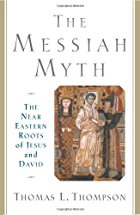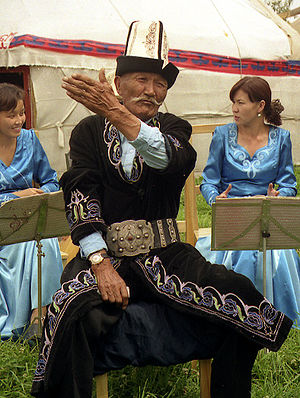 Thomas L. Thompson has hit the nail on the head when he explains why “historians” of the Bible place so much emphasis on oral tradition. Oral tradition, of course, is not a fact. That it existed cannot be verified. It is nothing more than a hypothesis, or really more an assumption of necessity than a hypothesis. And the necessity is the trap that scholars have built for themselves by assuming — the great unquestionable assumption — that the gospels ultimately get their stories from some historical events and persons.
Thomas L. Thompson has hit the nail on the head when he explains why “historians” of the Bible place so much emphasis on oral tradition. Oral tradition, of course, is not a fact. That it existed cannot be verified. It is nothing more than a hypothesis, or really more an assumption of necessity than a hypothesis. And the necessity is the trap that scholars have built for themselves by assuming — the great unquestionable assumption — that the gospels ultimately get their stories from some historical events and persons.
Before we can speak of a historical Jesus, we need a source that is independent of Matthew, Mark and Luke and refers to the figure of the early first century. Such an ideal source, of course, is hardly to be hoped for . . . . The problem with using the far from ideal gospels as sources for history has attracted great attention to oral tradition.
And the necessity for these oral traditions?
They could help, however, in bridging the considerable gap between the time in which the gospels were written and that earlier time in which they set Jesus.
Enter the Gospel of the Gaps
Before the Gospel of Thomas was discovered, this oral source for the sayings common to Matthew and Luke (Q) was defined by the striking similarity of Jesus’ sayings in a fourth-century translation reawakened these old speculations about Q. . . . [This Gospel of Thomas was] corroborating evidence for an oral tradition of sayings [that] supported the hope that a comparison of Q with Thomas could help in distinguishing earlier from later sayings. If the sayings in Thomas are earlier than the gospels, scholars would be closer to identifying the earliest of them as Jesus’ own.
Meaning?
Necessity, once more, was the mother of invention. Even though the Greek original of the Gospel of Thomas could hardly have been earlier than the second century, the similarities of the sayings in Thomas to Q have seduced many. Thomas can fill the gap separating a historical Jesus from the earliest of the gospels and therefore it does.
Leaving Thompson aside for a moment, Nicholas Perrin’s book (sorry April DeConick), Thomas and Tatian: The Relationship between the Gospel of Thomas and the Diatessaron (link is to Google books) points to many word plays and various Syrian literary linking details that set the work apart as a literary, hardly an oral, creation.
The unlikely assumption (again)
This accepts the unlikely assumption that the sayings from Thomas were based on an oral tradition, rather than on the known gospels or on a tradition harmonizing them.
Thompson then alludes to Crossan’s and others’ efforts to distinguish the wisdom sayings from the apocalyptic ones. The idea of this distinction has been to identify the sayings of a wisdom ‘historical’ teacher from a later layer of apocalyptic sayings introduced subsequently by followers. Thompson rejects this distinction and argues (from a range of Jewish scriptures and other Middle Eastern sayings) that the apocalyptic and wisdom motifs as a rule went hand in hand throughout the centuries.
So why the conjuring up of oral tradition?
The tendency to evoke oral tradition to transmit the sayings from event to the writing of the gospels is required only by the assumption that the text is about a historical Jesus. The projected function of the sayings of Q and Thomas as oral sayings is to link the gospels with their text’s heroic teacher.
What’s wrong with what we’ve already got?
If, instead of Q and the collections of sayings in Thomas, we were to consider actually existing Jewish collections and sayings, such as the proverbs of Solomon, the songs of David or the laws of Moses, would we also conclude that such sayings originated with the figure to which the Bible attributes them? . . . . Such collections tell us nothing about a historical Solomon, David or Moses — not even whether they existed.
There is much more, of course. I’ve just hit a few salient points for a quick read on a blog.
Thompson’s book does not attempt to cover all that needs to be covered. He makes it clear that his goal is to demonstrate, in response to the historical Jesus research of Schweitzer and Crossan, that the sayings of Jesus can potentially derive from a far deeper pool of known literature than “fictive texts like Q”.
Unfortunately his work lacks the detail required to settle the question. But it is a provocative starter. Hopefully he will publish more to begin to flesh out some of the possibilities in detail.
The above quotations are from chapter one of Thompson’s The Messiah Myth.
Like this:
Like Loading...



 Thomas L. Thompson has hit the nail on the head when he explains why “historians” of the Bible place so much emphasis on oral tradition. Oral tradition, of course, is not a fact. That it existed cannot be verified. It is nothing more than a hypothesis, or really more an assumption of necessity than a hypothesis. And the necessity is the trap that scholars have built for themselves by assuming — the great unquestionable assumption — that the gospels ultimately get their stories from some historical events and persons.
Thomas L. Thompson has hit the nail on the head when he explains why “historians” of the Bible place so much emphasis on oral tradition. Oral tradition, of course, is not a fact. That it existed cannot be verified. It is nothing more than a hypothesis, or really more an assumption of necessity than a hypothesis. And the necessity is the trap that scholars have built for themselves by assuming — the great unquestionable assumption — that the gospels ultimately get their stories from some historical events and persons.